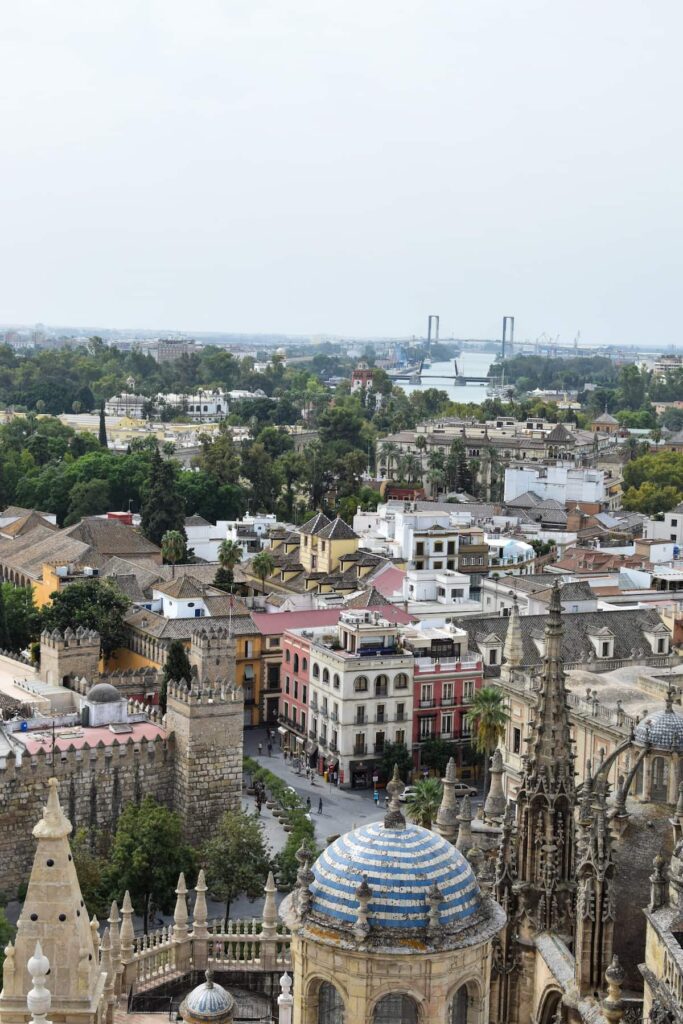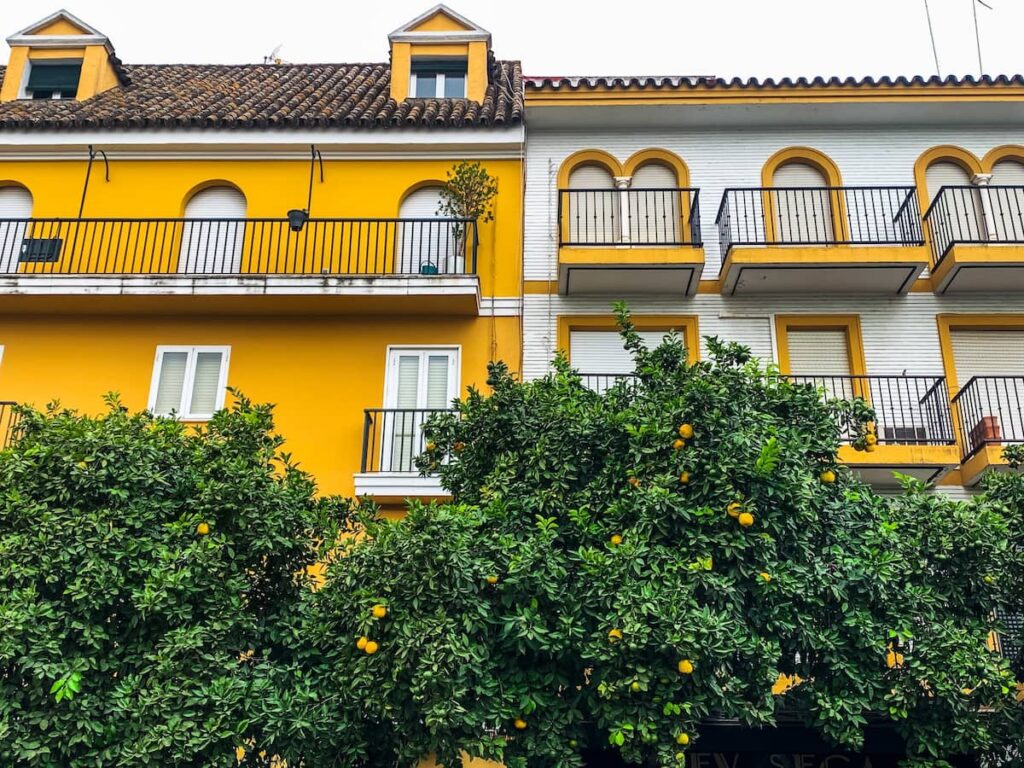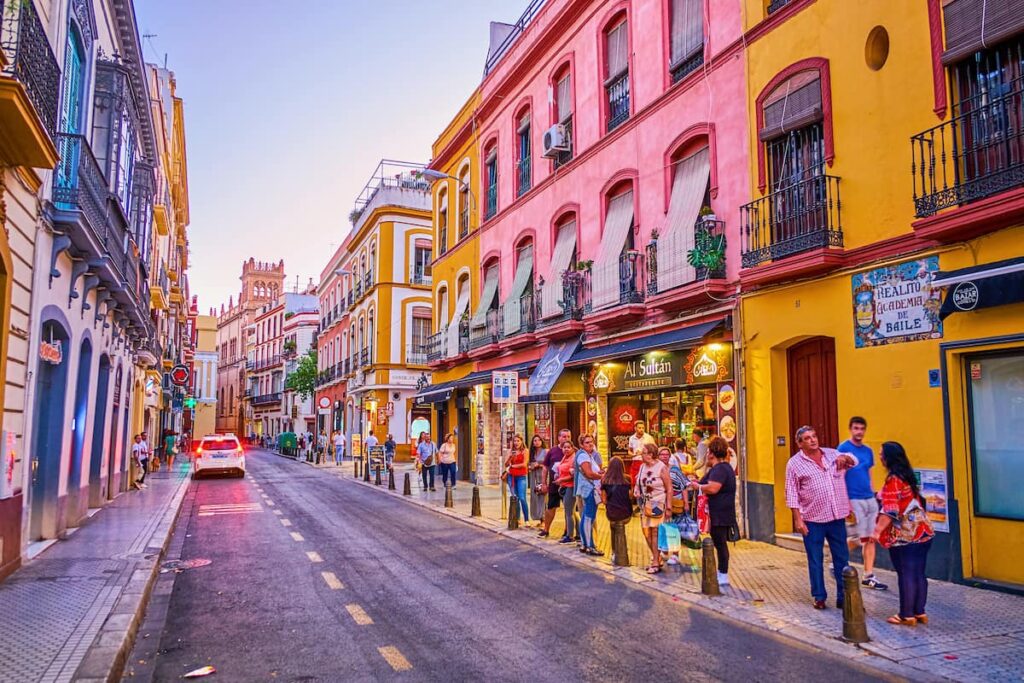If you’re planning a trip to Seville, Spain, you might be wondering about the best time to visit. The answer depends on what you want to see and do, as well as your tolerance for heat and crowds.
The great news is that there really is no bad time to visit the Andalucian capital… but your travel preferences will come into play. In this article, you’ll get an overview of Seville’s seasons, when to go, and an overview of what’s happening in Seville month by month. By the end, you’ll be able to make the best decision on how to time your Seville trip!
Best Time to Visit Seville, Spain: Quick Answer
The best time to visit Seville is during the spring months of March to May when the temperatures are mild, and the city is bursting with color and energy. This is also the time when the famous Holy Week and April Fair celebrations take place, making it an ideal time to experience the city’s rich culture and traditions.
If you want to avoid the crowds and enjoy pleasant weather, the shoulder season of February or November is also a great option.

Best Time to Visit Seville: By Season
Weather can make or break a holiday so it’s no surprise that every travel destination has a peak season where tourists arrive in hoards due to the favorable weather. But traveling in the off-season also has its perks.
Here’s a look at Seville’s travel seasons and some things to consider when planning your trip.
High Season in Seville
The high season in Seville is from March to June and September to October. This is the best time to go for outdoor activities, as the temperatures are pleasant and there is little rain. The days are hot, with plenty of sunshine, and the nights are warm.
However, this is also the busiest time of the year, so expect larger crowds and higher prices.
April and May can be especially crowded as that’s when Seville celebrates some of its most important festivals (more on that below).
I’ve visited Seville in October and would highly recommend it. The weather is still warm and toasty without being uncomfortable – just perfect!
Shoulder Season in Seville
The shoulder season in Seville is from December to February. During this time, the crowds are smaller, and the weather is mild. The average temperature during these months is around 15°C (59°F), which is perfect for exploring the city.
However, these are some of the wettest months in Seville so you should be prepared for occasional rain, so make sure to pack an umbrella or raincoat.
If you don’t mind the cooler temperatures, the winter months are a great time to visit Seville. The daytime temperatures are pretty high and the warm sunshine helps but it can get as low as 6°C (43°F) at night. Plus, the city is beautifully decorated for Christmas in December and there are fewer crowds, making it a great time to explore the city’s attractions.
I personally also enjoy Seville in the winter as it’s less frantic and crowded while not being too cold.
Seville in Summer
You may be wondering, what about summer in Seville? Well, Seville’s central inland location makes it sweltering hot during the summer, particularly in July and August. In fact, many locals leave during this time in search of cooler weather!
If you can only visit Seville in summer, you can still enjoy your visit. Just be mindful of the heat. Stay hydrated and you may want to adopt the Spanish siesta as well to avoid the hottest time of day.
Overall, the best time to visit Seville depends on your preferences. If you want to avoid crowds and don’t mind cooler temperatures, the shoulder season and winter months are great periods to visit. However, if you want to experience the city’s festivals and events and don’t mind larger crowds, the high season is the best time to go.

When to Visit Seville: Month-by-Month Overview
Now that you have a better sense of the various tourist seasons in Seville, let’s get a more detailed look into what you can expect depending on when you visit.
Seville in January
January is the coldest month in Seville, with average temperatures ranging from 9°C (48°F) to 16°C (61°F).
Despite the chilly weather, January is the least crowded month, making it a good time to visit if you prefer a quieter atmosphere. However, you should be prepared for some rain, as January is one of the wettest months of the year in Seville.
Seville in February
February is slightly warmer than January, with average temperatures ranging from 10°C (50°F) to 18°C (64°F). The weather is still cool, but the city starts to come alive with the approach of Carnival and Valentine’s Day. It’s a great time to explore the city’s museums and monuments, and to enjoy some of the local cuisine.
I’ve visited Seville in February and I found the weather very pleasant. There was lots of sunshine and it felt pretty warm in the afternoons. There were even a few afternoons when it was warm enough to be in just short sleeves! It did get colder when the sun set.
Seville in March
As March rolls around, the weather gets warmer and more tourists start arriving. That’s because March is one of the best months to visit Seville, with mild temperatures ranging from 12°C (54°F) to 21°C (70°F). The weather is perfect for outdoor activities, such as sightseeing, walking tours, and bike rides.
March is also the month of the famous Seville Spring Fair, which is a must-see event if you’re in the city at this time of year.
Seville in April
April is another great month to visit Seville, with temperatures ranging from 13°C (55°F) to 23°C (73°F). The weather is warm and sunny, making it perfect for exploring the city’s parks and gardens.
April is also the month of Holy Week, which is one of the most important religious festivals in Seville. Semana Santa in Seville is very impressive and ornate and attracts thousands of visitors each year. If you’re interested in experiencing this event, be sure to book your accommodation well in advance.
Seville in May
May is the start of the summer season in Seville, with temperatures ranging from 16°C (61°F) to 27°C (81°F). The weather is warm and sunny, but not too hot, making it a great time to visit if you prefer milder temperatures.
May is also a great month to enjoy some of the city’s outdoor activities, such as horseback riding, hiking, and cycling. Plus, Seville typically celebrates Feria de Abril (April Fair) during this time. Despite its name, it typically falls in early May, two weeks after the Holy Week celebrations.
Feria de Abril is an amazing way to experience Andalucian culture and it’s a busy time in the city. Similar to Holy Week, be sure to book your accommodations in advance.

Seville in June
As we go deeper into summer, Seville heats up!
June is the beginning of the hot summer season in Seville, with temperatures ranging from 20°C (68°F) to 32°C (90°F). The weather is hot and dry, but the city is still bustling with activity. June is a great month to enjoy some of the city’s indoor attractions, such as museums, galleries, and theaters.
If you have to visit in summer, June is probably the best time to go before the weather gets crazy hot…
Seville in July
Summer truly arrives in Seville in July. It’s one of the hottest months in Seville, with temperatures ranging from 23°C (73°F) to 36°C (97°F). The weather is extremely hot and dry, making it a challenging time to visit if you’re not used to the heat.
However, if you’re looking for a summer holiday destination with plenty of sunshine, Seville is a great choice.
Seville in August
August is another hot and dry month in Seville, with temperatures ranging from 23°C (73°F) to 36°C (97°F). The city is quieter than usual, as many locals go on vacation during this month. However, there are still plenty of things to see and do, such as visiting the city’s historic sites and enjoying the local cuisine.
Seville in September
With summer on its way out, the weather cools down a bit in September. This is a great time to visit Seville. The weather is still warm and sunny, with temperatures ranging from 20°C (68°F) to 32°C (90°F), but it’s not as hot as in July and August (phew!).
Now’s the time to September enjoy some of the city’s outdoor activities, such as hiking, cycling, and horseback riding.
Seville in October
On my first visit to Seville, I came in October and absolutely loved it! In October, Seville is still warm and sunny but with mild temperatures ranging from 16°C (61°F) to 26°C (79°F), it’s a lot more comfortable than the preceding months!
The weather in October is perfect for outdoor activities, such as walking tours, bike rides, and sightseeing. October is also the month of the Seville International Film Festival, which is a great event for movie lovers.
Seville in November
Seville’s weather in November is typically mild with average temperatures ranging from 11°C (52°F) to 20°C (68°F). It’s a good time to visit if you want to avoid crowds and enjoy lower prices. Pack layers for chilly mornings and evenings, but prepare for warmer afternoons.
November marks the start of the rainy season, so bring a rain jacket and umbrella just in case.
Seville in December
In December, Seville’s weather is mild, with daytime temperatures averaging around 16°C (61°F) and nighttime temperatures dropping to around 8°C (46°F). It is one of the coldest months in Seville, but still mild compared to many other parts of Europe.
The city may experience occasional rain and cloudy skies during this month so you’ll need warm clothing, such as a coat or jacket, and an umbrella in case of rain. December is also the month of Seville’s famous Christmas and New Year’s celebrations, making it a festive time to visit the city.

Festivals and Events in Seville
Let me tell you, Seville knows how to party! If you want to experience the vibrant culture of Seville, you should plan your trip around one of the city’s many festivals and events.
Here are some of the most popular ones.
Semana Santa (Holy Week)
Semana Santa (Holy Week) is a week-long celebration that takes place in the lead-up to Easter Sunday. During this time, Seville is filled with colorful processions of floats carrying religious figures, accompanied by marching bands and crowds of locals and tourists alike.
The most impressive processions take place on Maundy Thursday and Good Friday, when the floats are adorned with thousands of flowers and candles.
Feria de Abril
The Feria de Abril (April Fair) is another major event on Seville’s calendar. This week-long festival is held two weeks after Semana Santa and is a celebration of Andalusian culture, with flamenco dancing, bullfighting, and plenty of food and drink. The fair takes place in a large temporary city of casetas (tents), which are decorated with colorful lights and offer music, dancing, and traditional food and drink.
Seville comes to life during this fun cultural festival and it’s one of the ways to experience local culture. Visiting Seville during Feria de Abril is sure to be unforgettable!
Flamenco Shows
Flamenco is an integral part of Seville’s culture, and there are many venues throughout the city where you can see live performances. Some of the most popular places to see flamenco include El Patio Sevillano, La Carbonería, and Casa de la Memoria.
Every two years, Seville hosts the Bienal de Flamenco, one of the world’s best flamenco festivals. The festival features renowned flamenco artists from all over the world and there are performances all over town including the Teatro Lope de Vega and the Real Alcázar. There are also exhibitions, workshops, and conferences about flamenco culture and history.
Bienal de Flamenco is a must-see for any flamenco enthusiast or cultural explorer visiting Seville. The festival is usually held in September and lasts for about two weeks.
Check out the official website for details on the next festival in 2024.
Tip: If you’re planning to visit Seville during a festival or event, it’s important to book your accommodation and restaurants well in advance, as these can fill up quickly. You should also be prepared for large crowds and busy streets, especially during Semana Santa and the Feria de Abril.

Best Time to Visit Seville, Spain: FAQs
When is the best time to visit Seville?
The best time to visit Seville is in the spring (March to May) and fall (September to November) when the weather is mild and comfortable for outdoor activities. Spring is particularly special in Seville as the city celebrates a few festivals during that period!
Is summer a good time to visit Seville?
Summer (June to August) can be extremely hot and humid, with temperatures often reaching over 38°C (100°F). However, if you don’t mind the heat and want to experience the lively summer festivals and events, it can be a good time to visit. Just be prepared for the heat…
Is winter a good time to visit Seville?
I have visited Seville in winter and enjoyed it very much! Winter (December to February) can be cool and rainy, with temperatures averaging around 15°C (60°F). The daytime is generally pretty warm and sunny but the temperature does drop in the evening so layers are essential.
While it may not be the ideal time for outdoor activities, winter is a great time to experience Seville’s cultural attractions without the crowds.
What is the weather like in Seville?
Seville has a Mediterranean climate with hot, dry summers and mild, wet winters. In the summer, temperatures can reach up to 40°C (105°F), while winter temperatures average around 15°C (60°F). For more information on Seville’s climate and weather, read our article here.
How should I dress for Seville weather?
During the summer, it’s important to wear light, breathable clothing and bring sunscreen and a hat to protect yourself from the sun. In the winter, it’s best to dress in layers and bring a waterproof jacket in case of rain.
For more on Seville
- One Day Seville Itinerary: See the Best of Seville in 24 Hours
- The Ultimate Guide to Seville in 2 Days
- 4 Days in Seville: What to See and Do for an Unforgettable Trip
- Seville to Cordoba Day Trip
- Gibraltar Day Trip from Seville
- Seville to Granada Day Trip
- Best Things to Do in Seville at Night (2023 Guide)

Liza’s love affair with Spain began when she started taking Spanish language classes. Since then, she regularly travels to Spain to explore new places and discover new things to love about this gorgeous country. This travel blog is her way of sharing her love of Spain and helping you plan your dream Spanish holiday!
